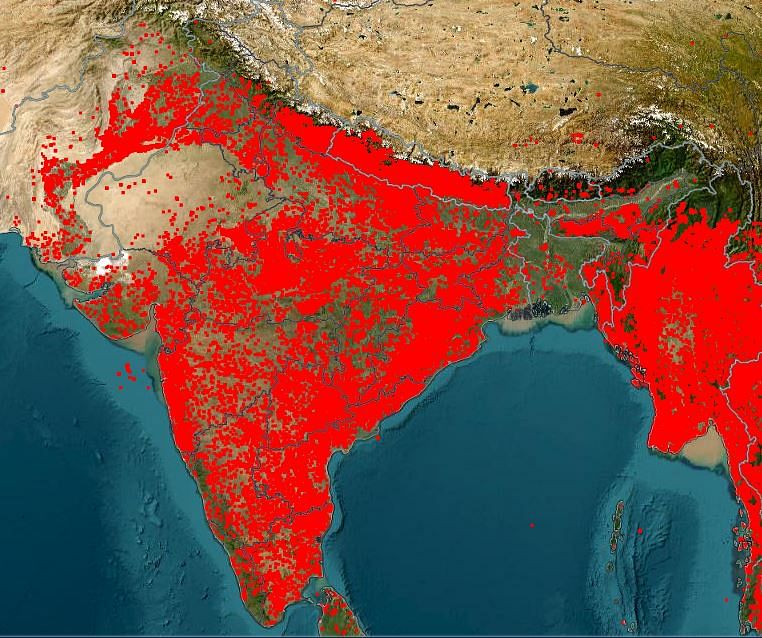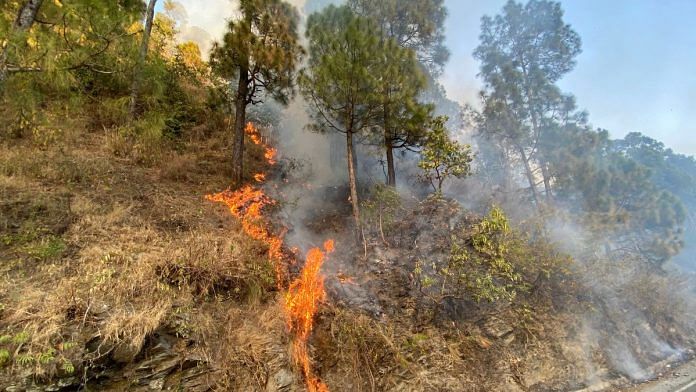New Delhi: The forests of Uttarakhand are battling an increasing number of fires blazing through the state every year. According to data from the state’s forest department, different parts of Uttarakhand saw 804 forest fire incidents in March 2023, rising to 1,046 in the following month of April. This year, the number has multiplied at an alarming rate to 5,710 in April from 585 in March.
Forest officials said that the March-to-May period is when the state usually sees a spike in forest fires. The month of May is yet to begin.
The forest department data showed that over 110 hectares of forest cover had been gutted down by the current spell of fire as of the morning of 29 April. Between January and April this year, around 730 hectares of forest land was impacted.
“The operation is on. We have roped in the Indian Air Force and the National Disaster Response Force (NDRF) to douse the fire. Forest fire management is not like a fire incident in an urban area. Many areas become inaccessible. This is also an open area with trees and dried leaves, which makes it easier for the fire to spread,” an Uttarakhand forest department official told ThePrint on Monday.
The worst affected districts in the state are Nainital, where 1,524 fires have been reported this year so far, followed by Champawat with 1,025 fires, and Almora, which has reported 909 forest fires.

Lack of ample rainfall and high temperatures have their role to play in the devastating forest fires raging through Uttarakhand. But according to experts, another reason behind the rise in the number of such incidents every year is the reduction in forest cover due to urbanisation.
The possible factors
India Meteorological Department (IMD) data shows that in January, the state recorded a mere 0.1 mm rainfall as against the normal of 32 mm for the month, leading to a 99 percent rainfall deficit.
Mahesh Palawat, vice president (Meteorology and Climate Change), Skymet Weather — a private weather forecasting agency — explained that Uttarakhand has been experiencing a major rainfall deficit this year.
“This season has remained fairly dry for Uttarakhand. No rains have been reported in the state. Western disturbances are active in the region, but they have only reached Himachal Pradesh, not Uttarakhand,” he said.
He added that due to the lack of rain for such a prolonged period, the moisture levels in the soil and in the overall forest remain low. This means that a minor spark can turn into a large-scale fire.
“Dry leaves cause friction and also spread the fire to a larger area. High temperatures also tend to ignite fires,” he said.
Experts said that most of these fires are human-induced and can be controlled by increased vigilance and awareness in the neighbouring areas. If these sparks are detected and controlled at an early stage, the damage can be minimised.
“Many villages surrounding the forest areas light fires for cooking or for clearing the leaves. This often spreads and becomes uncontrollable. We have also noticed that residents claim to douse the fires after their use, but they often don’t douse completely and reignite. The forest department and local activists have been conducting awareness campaigns to educate the locals, but we have not been seeing fruitful results,” said Madhav Rao, an environmental activist in Almora.
Uttarakhand forest officials said that the latest fires could also have been a result of such human negligence. While a detailed investigation into the causes is pending, the state government has filed around 196 cases against “anti-social elements” for starting the fires.
Also Read: Karnataka, Gujarat best in renewable energy transition, Jharkhand, Bihar lag—think tank report
How prone are India’s forests to fires?
Satellite data from the National Aeronautics and Space Administration (NASA) and the Indian Space Research Organisation (ISRO) has highlighted a worrying picture. The NASA fire maps are filled with ‘red dots’, representing medium to large fires raging along the Himalayan foothills, the southern peninsula and around eastern India over the past week.

IMD officials said that in most states, the fires could be a result of intense heat.
“Eastern and southern parts of the country have been experiencing heatwave conditions over the last few weeks. High daytime temperatures and clear skies often become conducive factors for causing such fires. Dry winds also contribute to its spreading,” said IMD Director General M. Mohapatra.
A 2021 report by the Forest Survey of India (FSI) highlighted that around 36 percent of India’s total forest cover is prone to frequent fires. Of these, 4 percent come under the ‘extremely prone’ category, and 6 percent are categorised as ‘very highly prone’.
The report also said that Odisha, Madhya Pradesh and Chhattisgarh reported the most forest fires.
“Based on the forest inventory records, 54.40 percent of forests in India are exposed to occasional fires, 7.49 percent to moderately frequent fires and 2.40 percent to high incidence levels, while 35.71 percent of India’s forests have not yet been exposed to fires of any real significance,” the FSI report read.
It also warned of long-term impacts of such large and recurrent fires. “Precious forest resources, including carbon locked in the biomass, are lost due to forest fires every year, which adversely impacts the flow of goods and services from forests,” the report noted.
Also Read: Curious case of squeaky clean Varanasi air — too few sensors, data collection gaps fan questions
Tools for early detection and warning
According to FSI officials, “near real time” warnings, using sensors and satellite monitoring, are being issued to states. The department uses MODIS (Moderate Resolution Imaging Spectro-Radiometer) on board the AQUA and TERIS satellites of NASA to detect fire hotspots. It also uses the SNP-VIIRS (Suomi National Polar-orbiting Partnership-Visible Infrared Imaging Radiometer Suit).
ISRO, which has developed the BHUVAN portal with its earth observation satellites, also gives out regular updates to state governments on the location and intensity of fires.
“The very purpose of earth observation satellites is to provide information on various aspects of natural calamities and resource distribution in the country. BHUVAN provides a lot of information regarding water, agriculture, forest, infrastructure and tourism activities in the country. Each government consumer has a different demand and the satellite data can be customised as per their requirement,” an ISRO official said.
ISRO’s satellite monitors regions within a smaller range (1 km x 1 km). It gauges land temperatures beyond certain levels and alerts agencies of the location of the fires, which helps rescue teams target their operations.
However, officials agreed that for a long-term solution, vigilance needs to be improved on the ground.
In a post on X, Mohan Pargaien, principal chief conservator of forests in Telangana, pointed out how small-scale forest fires can be caught during forest inspections and controlled by the department. Sharing a video of the forest staff extinguishing forest fires in Manuguru using blowers from April 28, he said, “This is how our field staff extinguishes forest fires using a blower.”
Our field staff are busy in extinguishing forest fire using blower . This ?is from Manuguru of #Kothagudem #Telangana #ForestFire @TelanganaToday @IndianExpress @HindustanTimes @timesofindia @ndtvindia @pantlp @oratorgreat @Rameshbhimtal pic.twitter.com/jGE4e93rOt
— Mohan Pargaien IFS?? (@pargaien) April 28, 2024
(Edited by Mannat Chugh)
Also Read: Ghazipur landfill fire controlled after 36 hrs & 45 tenders, but threat of more blazes looms






